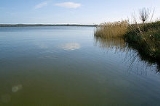
Arlington Reservoir
Encyclopedia
Arlington Reservoir is a 99.4 (245.6 acre) biological Site of Special Scientific Interest
in Arlington, East Sussex
. The site was notified in 1985 under the Wildlife and Countryside Act 1981
. The site is also of ornithological interest, with over 1% of the wintering wigeon being populated within the site. Alder Alnus glutinosa and willow Salix species are part of the open water. The site is also home to a scrub of Crataegus monogyna. A large jetty juts into the water and a few hundred yards away there is a water treatment building. The reservoir was originally created by damming the River Cuckmere
, which previously meandered to the middle of the present-day reservoir. The Cuckmere is now channelled in a straight line just to the east.
Often referred to as the jewel of Sussex, it is a magnet for kite flyers and dog walkers alike.
, swallow
, mallard
, pied wagtail, coot
, Canada goose
, rook
, and sheep graze in the surrounding water meadows. Black swan
s, presumably escapes from captivity, can often be seen on the water.
Site of Special Scientific Interest
A Site of Special Scientific Interest is a conservation designation denoting a protected area in the United Kingdom. SSSIs are the basic building block of site-based nature conservation legislation and most other legal nature/geological conservation designations in Great Britain are based upon...
in Arlington, East Sussex
Arlington, East Sussex
Arlington is a village and civil parish in the Wealden district of East Sussex. The parish is on the River Cuckmere, and is the location for a medieval priory, a reservoir and car racetrack.-History:The area has been settled since Anglo-Saxon times...
. The site was notified in 1985 under the Wildlife and Countryside Act 1981
Wildlife and Countryside Act 1981
The Wildlife and Countryside Act 1981 is an Act of Parliament in the United Kingdom and was implemented to comply with the Directive 2009/147/EC on the conservation of wild birds...
. The site is also of ornithological interest, with over 1% of the wintering wigeon being populated within the site. Alder Alnus glutinosa and willow Salix species are part of the open water. The site is also home to a scrub of Crataegus monogyna. A large jetty juts into the water and a few hundred yards away there is a water treatment building. The reservoir was originally created by damming the River Cuckmere
River Cuckmere
The River Cuckmere rises near Heathfield in East Sussex, England on the southern slopes of the Weald. The name of the river probably comes from an Old English word meaning fast-flowing, since it descends over 100 m in its initial four miles...
, which previously meandered to the middle of the present-day reservoir. The Cuckmere is now channelled in a straight line just to the east.
Often referred to as the jewel of Sussex, it is a magnet for kite flyers and dog walkers alike.
Local wildlife
At the northwest banks of the reservoir is the Osprey Birdhide, and this is the best place to see the population of cormorants which regularly come to sit on the Banks and trees surrounding water. Other species include great crested grebeGreat Crested Grebe
The Great Crested Grebe is a member of the grebe family of water birds.- Description :The Great Crested Grebe is long with a wingspan. It is an excellent swimmer and diver, and pursues its fish prey underwater. The adults are unmistakable in summer with head and neck decorations...
, swallow
Barn Swallow
The Barn Swallow is the most widespread species of swallow in the world. It is a distinctive passerine bird with blue upperparts, a long, deeply forked tail and curved, pointed wings. It is found in Europe, Asia, Africa and the Americas...
, mallard
Mallard
The Mallard , or Wild Duck , is a dabbling duck which breeds throughout the temperate and subtropical Americas, Europe, Asia, and North Africa, and has been introduced to New Zealand and Australia....
, pied wagtail, coot
Coot
Coots are medium-sized water birds that are members of the rail family Rallidae. They constitute the genus Fulica. Coots have predominantly black plumage, and, unlike many of the rails, they are usually easy to see, often swimming in open water...
, Canada goose
Canada Goose
The Canada Goose is a wild goose belonging to the genus Branta, which is native to arctic and temperate regions of North America, having a black head and neck, white patches on the face, and a brownish-gray body....
, rook
Rook (bird)
The Rook is a member of the Corvidae family in the passerine order of birds. Named by Carl Linnaeus in 1758, the species name frugilegus is Latin for "food-gathering"....
, and sheep graze in the surrounding water meadows. Black swan
Black Swan
The Black Swan is a large waterbird, a species of swan, which breeds mainly in the southeast and southwest regions of Australia. The species was hunted to extinction in New Zealand, but later reintroduced. Within Australia they are nomadic, with erratic migration patterns dependent upon climatic...
s, presumably escapes from captivity, can often be seen on the water.

